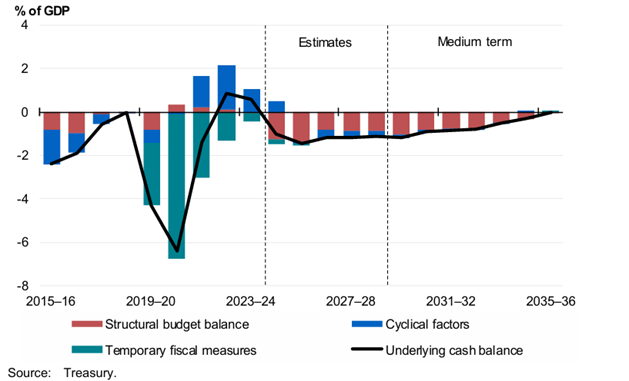The 2025-2026 Federal Budget
March 2025
In Summary: Implications for Investors and the Economy
The Federal Budget is a pre-election budget designed to address key voter concerns, particularly cost-of-living pressures. The government has significantly increased spending, with expenditures rising by nearly 2 percentage points of GDP (approximately $100 billion) over two years. This increase will support economic growth, business activity, and household finances. However, the full implementation of the proposed measures will depend on whether the government secures re-election in the upcoming May elections.
Cost of Living Relief
Recognising the financial strain on households, the budget includes small but unexpected tax cuts. Starting in June 2026 and June 2027, the lowest tax rate for earners between $18,201 and $45,000 will be reduced from 16% to 15% and later to 14%. Additional spending measures include a six-month extension of subsidies for energy bills, as well as a multitude of spending initiatives across a broad range of areas.
Economic Growth and Budget Position
The budget forecasts a deficit of $27.6 billion (1% of GDP) for the current fiscal year, slightly better than the previously estimated $28.3 billion deficit. However, next year’s deficit is projected to rise to $42.1 billion (1.5% of GDP), reflecting increased spending and income tax cuts. While these figures appear large, they remain relatively modest compared to Australia’s $2.8 trillion economy and in contrast to the U.S., which has been running deficits exceeding 6% of GDP.
The structural budget deficit, illustrated in the chart below, is estimated at nearly 1.5% of GDP, compared to a previously reported small surplus. This deficit results from sustained spending programs, including defence, healthcare, and aged care. The additional spending is expected to be financed by a forecast rebound in real economic growth.
Structural Budget Balance

Employment and Migration
The government forecasts a steady unemployment rate of 4.25% for the next 30 months, which may be an optimistic assumption given global uncertainties. The budget also projects a slowdown in net overseas migration, declining from 335,000 this year to 225,000 by 2026-27, which could constrain economic growth.
Key Support Measures for Businesses
- Small business support: Electricity subsidies, grants for energy efficiency upgrades, and tax relief measures to support operations and investment.
- Construction and housing: Faster contractor payments on government projects, cracking down on illegal and unfair business practices and incentives to boost homebuilding and affordability.
- Hospitality sector support: Tax concessions for breweries, distilleries, and wineries, including a pause on draught beer excise indexation.
- Workforce and productivity: Funding for free TAFE positions, wage increases in aged care and earmarking $900 million for the National Productivity Fund.
- Defence spending: Increased spending to bolster national security and defence capabilities.
Government Forecasts, Inflation and Interest Rates
The Government’s economic forecasts closely align with those published by the Reserve Bank of Australia (RBA) in its February Statement on Monetary Policy. Both projections suggest a soft landing for the economy, with inflation easing, allowing for modest interest rate cuts that, in turn, support a reacceleration of economic growth and a sustained low unemployment rate.
The additional government spending is not expected to significantly impact inflation, which is already moderating. However, it could influence the RBA’s decisions regarding interest rate cuts. Inflation is expected to return to target six months earlier than projected, which should support a more stable economic environment.
If the current government is re-elected, the likelihood of multiple rate cuts diminishes as spending places upward pressure on inflation. Conversely, an opposition victory, accompanied by spending cuts, could lead to more aggressive rate reductions.
Market Implications
While Australian budgets typically have limited direct effects on financial markets, tax and spending initiatives can influence specific sectors. The increased government spending in this budget will likely support economic growth.
For investors, the budget presents a mixed outlook:
- Positive for Consumer Spending: Tax cuts and cost-of-living measures should boost discretionary income, benefiting the retail and consumer sectors.
- Support for Construction and Housing: New housing initiatives and contractor payment reforms will aid the struggling construction industry.
- Potential Headwinds for Interest Rate Policy: Depending on the election outcome, fiscal policy may influence the RBA’s ability to cut rates.
Conclusion
This budget reinforces the government’s commitment to addressing cost-of-living pressures, supporting key industries, and maintaining economic stability. However, the fiscal outlook remains sensitive to election results, global economic conditions, and inflation trends. While the budget provides short-term economic support, longer-term structural challenges, including budget deficits and global trade uncertainties, remain key considerations for investors.
Disclaimer and Credits
This content has been produced by Economist, Ivan Colhoun and Quilla Consulting.
Quilla Consulting Pty Ltd (Quilla) holds AFSL 511401. This document provides general advice only and not personal financial advice. It does not take into account your objectives, financial situation or needs. Before acting or making any investment decision, you should consider your personal financial situation or needs, consult a professional adviser, and consider any applicable disclosure documents.
Information in this document is based on sources believed to be reliable, but Quilla does not guarantee its accuracy. All opinions expressed are honestly held as at the applicable date. Neither the information, nor any opinion expressed, constitutes an offer, or invitation, to buy or sell any financial products. Quilla does not accept any liability to any person or institution who relies on this document and the information it contains and shall not be liable for any loss or damage caused to any person in respect of this document and the information it contains.
This report contains information that is confidential and proprietary to Quilla. You must not use this document, nor the information in it, for any purpose other than that for which Quilla agreed to provide it to you. You must not copy, modify, sell, distribute, adapt, publish, frame, reproduce or otherwise use any of the information in this document without the prior written consent of Quilla.

